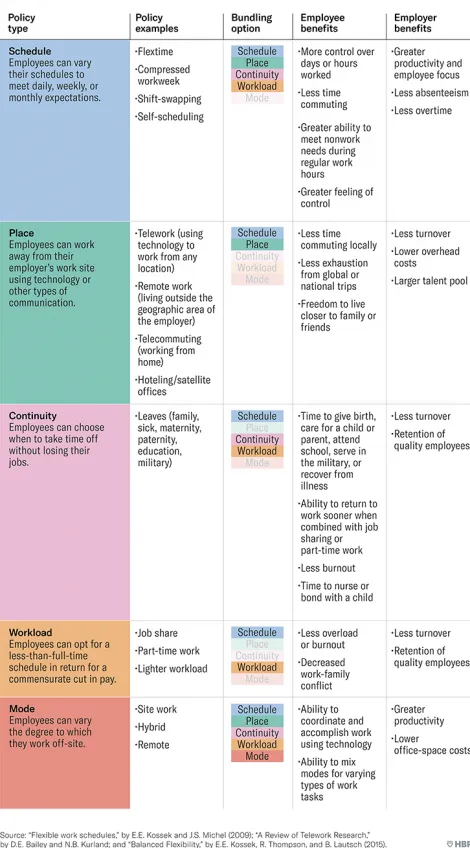How To Improve Flexibility at Work
Table of contents

The only thing you can count on not to change at work (and in life!) is that everything changes. So, if you want to reach your highest potential—and enjoy your work along the way—the best thing you can do? Learn to roll with those changes and be more flexible at work.
Adopting the changes at work isn't just important for your own performance and experience in the workplace—it's also important to employers. According to 2018 research from Barclays LifeSkills(opens in a new tab), 60 percent of employers said that adaptability, as a skill in the workforce, had become more important over the past decade—with 16 percent ranking it as their most important employability marker.
Clearly, flexibility at work is a must if you want to build a successful, sustainable career. But how, exactly, do you become more flexible—particularly if you're not a naturally "go with the flow" kind of person?
Let's take a look at actionable strategies you can use to improve flexibility at work:
Step outside of your comfort zone
When you do the same thing at work every day, improving flexibility becomes more challenging; the more stuck you are in your daily routine and your way of doing things, the harder it is to adapt and be flexible when that routine or way of doing things changes.
So, if you want to improve flexibility at work, a great place to start? Stepping outside of your comfort zone.
Getting out of your comfort zone and trying new things at work is a proactive way to become more adaptable and flexible at work; by taking the initiative to step outside of your daily routine, you're preparing yourself for the inevitable moment when changes to that routine are out of your control—and you'll be able to adapt better when those changes come as a result.
For example, let's say you work in IT and most of your job involves solving problems behind the scenes—and working alone at your desk is where you're very much comfortable. Instead of relaxing into the comfort of your behind-the-scenes role, step outside your comfort zone and volunteer to work on assisting customers with their tech issues; that way, if your role ever evolves into a more client-facing position, you'll be ready to dive in headfirst.
By switching things up and taking on a variety of tasks, responsibilities, and projects (even if those tasks, responsibilities, and projects feel a little uncomfortable), you're training yourself to adapt to new situations—so when the time comes that you have to adapt to a new situation at work, you'll have the flexibility you need to effectively navigate the transition without feeling too overwhelmed.
Practice compromise
Everyone has their own ideas on how to do things. But the most inflexible people at work are the ones who think _their _way is the only way.
One of the definitions of flexibility is "being willing to compromise." So, if you want to improve flexibility at work, you'll need to work on compromising with the people around you.
If you're the kind of person who's quick to take charge, taking a step back and making room for other people's opinions and ideas can be a great way to become more flexible. For example, let's say you get assigned to work on a project with some other team members—and while you think you should immediately dive in and start checking items off your to-do list, another co-worker thinks it would be best to dedicate the first few days of your project to planning. You might want to forge ahead with your own idea and start getting things done, agreeing to compromise with your team member and spend some time on the planning process is a great practice in flexibility; not only will it make it easier for you to adapt if you find yourself in a situation where you have to follow someone else's lead, but that compromise will make for a better working relationship with your colleague—and will make it easier to complete the project successfully. It's a win-win!
The point is, a little compromise goes a long way—and at work, a little compromise can make you a lot more flexible.
Give meditation a try
Becoming more flexible in your thinking is a fast track to becoming more flexible at work. And a fast track to becoming more flexible in your thinking?
Meditation.
Research(opens in a new tab) has shown a correlation between meditation (and, more specifically, mindfulness meditation) and higher levels of cognitive flexibility. So, if you want to encourage more flexibility in your thinking—and improve flexibility at work in the process—incorporating meditation into your routine is a great way to do it.
If the thought of meditation feels overwhelming, take a deep breath (pun intended); you don't need to meditate for hours at a time to reap the benefits. According to research from popular meditation app Headspace(opens in a new tab), just 10 to 20 minutes of meditation three times a week is all it takes to enjoy meditation's benefits—including more flexible thinking.
Partner with leadership and colleagues to create a culture of flexibility
Improving your own flexibility at work will improve your personal performance and productivity. But improving flexibility in the workplace will elevate performance and productivity at the organizational level—which is why, if you want to improve flexibility at work overall, you need to work on developing a more flexible workplace.
Partner with your leadership team to encourage more flexibility at an organizational level. For example, has your leadership team created a culture where you feel comfortable delivering feedback on what's not working—and feel confident that people will be open and flexible in receiving that feedback? If not, brainstorm ways that you can work on building that feedback culture together. Or do you feel like you have the flexibility to work how and where works best for you? If not, talk to your leadership team about rolling out flex work options; having the flexibility to work remotely can go a long way in keeping employees engaged and happy at work (a 2016 survey(opens in a new tab) found that 87 percent of people with the flexibility to work from home reported loving their jobs—compared to just 24 percent of people who are required to work in an office)—and if leadership wants your organization to perform at its highest level, it should be taking every step possible to keep the team engaged.
Bottom line? On an individual level, being more flexible at work will boost your performance. But creating a more flexible workplace will boost performance across the organization—so make sure to partner with leadership to encourage flexibility across the board.
For Managers: Review HBR's "Flexibility Primer."
A look at the five different types of flexibility your organization can consider (according to Harvard Business Review(opens in a new tab)) and how they might be bundled.

Become more flexible—and more successful—at work
Flexibility and adaptability are must-have traits if you want to build a successful, sustainable career. And with these tips, you have everything you need to improve flexibility at work—and become more successful in the process.
What are some ways you practice being more flexible at work?








